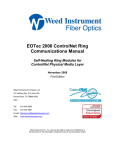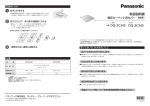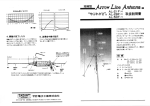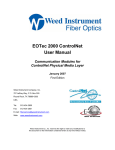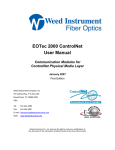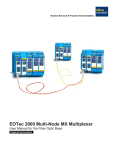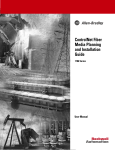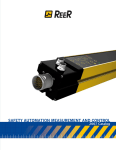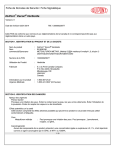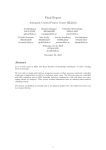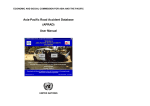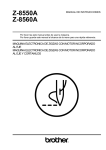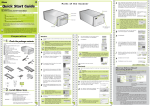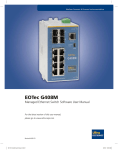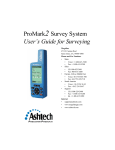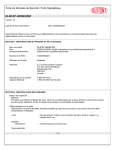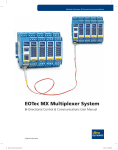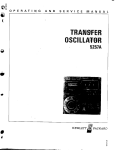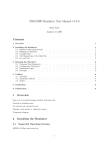Download User`s Manual Template - Ultra Electronics Nuclear Sensors
Transcript
EOTec 2000 ControlNet Ring Communications Manual Self-Healing Ring Modules for ControlNet Physical Media Layer July 2014 Second Edition Ultra Electronics, NSPI 707 Jeffrey Way, P.O. Box 300 Round Rock, TX 78680-0300 USA Tel: 512-434-2850 Fax: 512-434-2851 E-mail: [email protected] Web: www.ultra-nspi.com Ultra Electronics, NSPI reserves the right to make any modifications to this document or the information contained herein at any time without notice. Terms and Conditions STANDARD TERMS AND CONDITIONS OF SALE UNLESS OTHERWISE EXPRESSLY AGREED IN WRITING, ALL SALES ARE SUBJECT TO THE FOLLOWING TERMS AND CONDITIONS: www.ultra-nspi.com/information-central/terms-conditions/ Copyright Copyright © 2014 Ultra Electronics, NSPI All rights reserved. Reproduction without permission is prohibited. ii Standards and Warnings The EOTec 2000 ControlNet Ring Modules from Ultra Electronics, NSPI have been designed to meet the following standards. EMC immunity – IEC61326-1:1998 Equipment for Measurement, Control and Laboratory Use FM Approved for: Class I, Division 2, Groups A, B, C& D, T4 (0°C To +60°C) When used in Hazardous Locations: Class I, Division 2, Groups A, B, C & D, T4. Substitution of components may impair suitability for Class I, Division 2. Power, input and output (I/O) wiring must be in accordance with Class I, Division 2 wiring methods and in accordance with the authority having jurisdiction. Do not connect/disconnect equipment unless area is known to be non-hazardous and power is switched off. Certified components for use in a suitable enclosure. The maximum ambient temperature is 60°C. Installations shall comply with the relevant requirements of the National Electrical Code® (ANSI/NFPA 70), the Canadian Electrical Code® (CEC, CAN/CSA-C22.1) and any local electrical codes, where applicable. The Fiber Optic portion of the ControlNet Specification is somewhat limited in scope and Ultra Electronics, NSPI Fiber Optic Products have a more varied set of specifications based on field requirements and proven applications. The fiber portion of this series is not designed to be compatible with the fiber portion of the ControlNet Specification and, therefore, interconnection by fiber to any other manufacturer’s products is neither expressed nor implied. Lightning Danger: Do not work on equipment during periods of lightning activity. iii EOTec 2000 ControlNet™ Ring Communications Manual Table of Contents Table of Contents Chapter 1 Introduction ......................................................... 1 Introducing the EOTec 2000 Self-Healing Ring Modules ...............................1 EOTec 2C31 ControlNet Self-Healing Ring (SHR) .........................................2 EOTec 2C32 ControlNet Dual Self-Healing Ring (DSHR) ..............................2 Feature Overview ...........................................................................................3 Options and Accessories ...............................................................................3 Chapter 2 EOTec ControlNet Hardware .............................. 4 Key Self-Healing Ring Features .....................................................................4 Self-Healing Ring Module Overview ...............................................................5 Self-Healing Ring Module Features ....................................................................5 Master/Slave Switch Settings .......................................................................... 7 Switch Settings for Single Self-Healing Ring ................................................... 8 Switch Settings for Dual Self-Healing Ring...................................................... 8 Remote Relay - Alarm Jumper Settings .......................................................... 9 Module Disassembly........................................................................... 9 Module Reassembly ......................................................................... 11 Remote Relay Applications ............................................................................ 12 Individual Alarms .............................................................................. 12 Module Alarm ................................................................................... 12 Wiring Guidelines for Self-Healing Ring Modules.......................................... 13 Fiber Optic Cable Lengths ...........................................................................14 Optical Transceiver Specifications ...................................................................14 Estimated Cable Lengths .............................................................................. 14 Maximizing System Cables............................................................................ 14 ControlNet Self-Healing Ring Fault Indicators ..............................................15 Local and Remote Alarms ............................................................................. 16 4-20mA Fault Prediction ................................................................................ 17 Chapter 3 Network Configurations.................................... 18 Network Setup and Operation ......................................................................18 Supported Network Configurations ..............................................................19 Single Channel/Ring Communication ............................................................ 19 Dual Channel/Ring Communication .............................................................. 21 Single Channel Security................................................................................. 23 iv EOTec 2000 ControlNet™ Ring Communications Manual Table of Contents Dual Channel Security ................................................................................... 24 Network Configuration Tips ..........................................................................25 Chapter 4 Planning and Installation .................................. 26 Planning a Network ......................................................................................26 Understanding EOTec/ControlNet Terminology ............................................ 26 Understanding Coax Limitations .................................................................... 28 Understanding When to Use Repeaters ........................................................ 28 Understanding the Benefits of Fiber .............................................................. 29 Understanding Fiber Limitations .................................................................... 29 Understanding Optical Transceivers ............................................................. 29 Optical Transceiver Specifications ................................................................ 30 Understanding Fiber Attenuation ................................................................... 30 Understanding Propagation Delay ................................................................. 32 Example 1: Maximum Delay (Single Channel) ................................. 33 Getting to the Point-to-Point ............................................................. 35 Example 2: Maximum Delay (Dual Channel).................................... 36 Verifying Network Parameters ....................................................................... 38 Installing a Network ......................................................................................39 Coax Application Tips .................................................................................... 39 Fiber Application Tips .................................................................................... 39 Redundant Network Tips ............................................................................... 39 Network Bandwidth Tips ................................................................................ 40 Chapter 5 Troubleshooting ................................................ 41 Diagnosing Network Failures .......................................................................41 Interrupting Fault Indicators .........................................................................42 Power Supply Indicators ................................................................................ 42 Electrical Interface Indicator .......................................................................... 42 Optical Interface Indicators ............................................................................ 43 Link Active Indicator (2C32 Only) .................................................................. 43 Remote LED / Relay Indicators ..................................................................... 44 Chapter 6 Default Settings ................................................. 45 Factory Settings ...........................................................................................45 Master/Slave Switch ...................................................................................... 45 Remote Relays .............................................................................................. 45 v EOTec 2000 ControlNet™ Ring Communications Manual APPENDIX A Table of Contents Technical Specifications .................................. 46 General Specifications ....................................................................................46 Dimensions ..................................................................................................47 APPENDIX B Self-Healing Ring Product Series .................... 48 Optical Transceiver Specifications ...................................................................48 Available Dual Channel Cables ........................................................................48 Available Optical Converters ...........................................................................48 Accessories – Patch Cord Conversion Cables.....................................................49 APPENDIX C Service Information........................................... 50 Technical Support and Service ....................................................................50 Table of Figures Figure 1-1: Self-Healing Ring (SHR) ............................................................. 2 Figure 1-2: Dual Self-Healing Ring (DSHR) .................................................. 2 Figure 2-1: Product Features ........................................................................ 5 Figure 2-2: Master / Slave Switch.................................................................. 7 Figure 2-3: Single Channel Self-Healing Ring ............................................... 8 Figure 2-4: Dual Channel Self-Healing Ring.................................................. 8 Figure 2-5: Front Cover Latches ................................................................... 9 Figure 2-6: Remove PCBs ............................................................................ 9 Figure 2-7: Separate / Assemble PCBs......................................................... 9 Figure 2-8: Power Board ..............................................................................10 Figure 2-9: Power Board Silkscreen .............................................................10 Figure 2-10: Optical Board ...........................................................................10 Figure 2-11: Optical Board Silkscreen ..........................................................10 Figure 2-12: ControlNet Board .....................................................................11 Figure 2-13: ControlNet Board Silkscreen ....................................................11 Figure 2-14: Locate DIN Rail Tabs ...............................................................12 Figure 2-15: Reinstall PCBs .........................................................................12 Figure 2-16: Fault Indicator Levels ...............................................................15 Figure 3-1: Simple Single Ring Solution .......................................................19 Figure 3-2: Network Topology Interaction ....................................................20 vi EOTec 2000 ControlNet™ Ring Communications Manual Table of Contents Figure 3-3: Complete Single Ring Solution...................................................20 Figure 3-4: Simple Dual Ring Solution .........................................................21 Figure 3-5: Complete Dual Ring Solution .....................................................22 Figure 3-6: Single Ring Break ......................................................................23 Figure 3-7: Multiple Dual Ring Breaks ..........................................................24 Figure 4-1: Coax Segment Length ...............................................................28 Figure 4-2: Example 1 – Single Channel Maximum Delay ............................33 Figure 4-3: Example 2 – Dual Channel Maximum Delay ..............................36 Figure 5-1: Diagnostic Features ...................................................................41 Table of Tables Table 2-1: Power Features ............................................................................ 5 Table 2-2: Link / Fiber Features .................................................................... 6 Table 2-3: Coax Features ............................................................................. 7 Table 2-4: Remote Alarm Settings ................................................................ 9 Table 2-5: Product Wiring ............................................................................13 Table 2-6: Optical Transceiver Specifications ..............................................14 Table 4-1: ControlNet Terminology ..............................................................27 Table 4-2: Fiber Benefits ..............................................................................29 Table 4-3: Optical Transceiver Specifications ..............................................30 Table 4-4: Understanding Fiber Attenuation .................................................30 Table 4-5: Network Propagation Delay.........................................................32 Table 4-6: Node-1 to Node-2 CW ................................................................34 Table 4-7: Node-1 to Node-2 CCW ..............................................................34 Table 4-8: Node-1 to Node-4 CW ................................................................34 Table 4-9: Node-1 to Node-4 CCW ..............................................................34 Table 4-10: Node-2 to Node-4 CW...............................................................34 Table 4-11: Node-2 to Node-4 CCW ............................................................34 Table 4-12: Channel-A Propagation Delay ...................................................37 Table 4-13: Channel-B Propagation Delay ...................................................37 Table 4-14: Rockwell Device Delay ..............................................................38 Table 4-15: Ultra Device Delay.....................................................................38 vii EOTec 2000 ControlNet™ Ring Communications Manual Introduction 1 Introduction This manual describes the uses for the EOTec 2C31 and *ControlNet™ Self-Healing Ring (SHR) and 2C32 Dual Self-Healing Ring (DSHR) communication modules specially designed for connecting ControlNet devices on the Physical Media Layer in industrial field applications. ControlNet is swiftly being adopted by the industrial automation and control industry. Industrial applications often demand rugged, robust equipment that can provide high reliability in settings far removed from a comfortable, climate-controlled office environment. Devices attached to a network normally cannot tell what is happening elsewhere on the system. As a result, the responsibility for monitoring and reacting to faults in the network must fall on the ControlNet communication equipment that connects these devices. SelfHealing Ring modules are well suited to react to these faults by rerouting essential data to insure no unscheduled downtime. In this environment, real-time alarms are a vital feature to inform system administrators and operators when a problem occurs and prevent loss of any system data. Introducing the EOTec 2000 Self-Healing Ring Modules The EOTec 2000 Self-Healing Ring Modules are designed using patent pending technology to give reliable operation in harsh industrial environments. As shown in Figure 1-1 (single ring) and Figure 1-2 (dual ring), Ultra Electronics, NSPI provides various solutions for creating redundant communications topologies. Create the ControlNet communication ring that meets your needs; for single channel redundancy, or for dual-redundant channel configurations. You can also combine ring topologies with existing point-to-point, daisy-chain, and star topologies into one network. Both Ultra Self-Healing Ring modules support multi-mode fiber for short to medium range distances and single mode fiber for greater distances between your ControlNet devices. Fiber optic technology provides many advantages for industrial control applications. These include EMI/RFI immunity, the ability to run fiber optic cable through hazardous areas, and the ability to connect long distance communication links. Both EOTec 2C31 & 2C32 Modules come with LED indicators for local determination of communication failures and relay contacts to support a remote alarm system. In addition, each has redundant power supply inputs to provide a constant power source. Also, both fiber optic ports have diagnostics which provide a 4 to 20mA real-time output for measuring the received optical power level (light intensity) of all glass fiber cables. The global alarm is unique because it is passed between all modules. A set of relay contacts is provided on every module and will activate in an alarm condition. As a result, only one module needs to be connected to a remote alarm to alert when a fault has occurred anywhere within your network. * ControlNet is a registered trademark of ControlNet International, Ltd. 1 EOTec 2000 ControlNet™ Ring Communications Manual Introduction EOTec 2C31 ControlNet Self-Healing Ring (SHR) Figure 1-1: Self-Healing Ring (SHR) In ring topologies, an additional fiber path is added (shown in Figure 1-1) to insure that communication is maintained when a fiber break occurs. In a dual channel system (see Figure 1-2), there is one fiber optic ring to support Channel-A and a second, entirely separate fiber optic ring to support Channel-B. The DSHR also provides a third “DualChannel Link” communication path to increase redundancy for networks that cannot afford any unscheduled down time. EOTec 2C32 ControlNet Dual Self-Healing Ring (DSHR) Figure 1-2: Dual Self-Healing Ring (DSHR) 2 EOTec 2000 ControlNet™ Ring Communications Manual Introduction Feature Overview EOTec 2000 ControlNet Self-Healing Ring modules can support both Multi-Mode and Single-Mode optical modules and includes diagnostic features that are not offered as options on most other optical modules. Appendix B, EOTec 2000 ControlNet Self-Healing Ring Product Series, includes ordering information on Self-Healing Ring models and Optional Accessories. Your EOTec ControlNet SHR modules require no jumper configuration. All ControlNet communication modules come ready to meet any ControlNet™ network configuration. Each module comes with a Master/Slave switch located on the front of each unit. This switch must be set so that one Master module resides in each ring. See Master/Slave Switch for the proper switch settings for your ControlNet ring. Options and Accessories Contact your Ultra Electronics, NSPI sales representative to order any of these options or accessories. • • • Fiber optic patch cables (converts LC connection to your fiber cable termination) Optical Conversion – convert between multi-mode and single mode at fiber ports Dual-channel Link cables of various lengths See Appendix B – Self-Healing Ring Product Series for more information on options and accessories. 3 EOTec 2000 ControlNet™ Ring Communications Manual ControlNet Hardware 2 EOTec ControlNet Hardware This chapter describes how both the EOTec 2C31 ControlNet™ Self-Healing Module and the 2C32 ControlNet™ Dual Self-Healing Module are designed to give reliable operation in harsh industrial environments. Both these modules have direct electrical connections over coax cable to your ControlNet devices. The 2C31 is used to create a single ring to support redundancy for a single channel system. The 2C32 is used to create a dual ring to support dual-redundancy on both Channel A and B. Key Self-Healing Ring Features 2C31 Single and Dual Self-Healing Rings for High Reliability o Highest number of nodes supported o Fully compliant with ControlNet™ specification Small Form-factor Pluggable (SFP), High Performance Laser Optics o 1310nm lever-latch SFP laser transceiver o Real-time indication of fiber optic health o Single/Multi-mode conversion available Global Ring Failure Alarm with Comprehensive Diagnostics o Indicator and relay monitor o Four additional alarm relay outputs o Minimizes downtime 2C32 Compact Enclosure o Reduced installation space required o Standard 35 mm DIN-rail mounting Industrial Design o CE Marked o Class I, Division 2, Groups A, B, C & D, T4 Accessories Available o Duplex patch cords (LC to ST, LC to SC, etc.) o Link cables o Spare SFP Transceivers 4 EOTec 2000 ControlNet™ Ring Communications Manual ControlNet Hardware Self-Healing Ring Module Overview The quickest way to begin understanding the functional uses of the Ultra Self-Healing Ring (2C31 – Single Ring & 2C32 – Dual Ring) Modules is to split the module in half as shown in Figure 2-1. All data communication features are located on the bottom and all power and diagnostic features are located on the top with a Master/Slave switch located front and center. Figure 2-1: Product Features Additional understanding can be gained by further dissecting the module into its functional parts. For more detailed information refer to Table 2-1, Table 2-2, & Table 2-3 below. Self-Healing Ring Module Features Features Description Power 1, 2___ Remote Alarms Power Inputs: There are two 15-30Vdc inputs provided to accommodate applications requiring redundant power. Power 1, 2 Inputs Power Alarms: Each module comes equipped with local and remote alarms to assist in diagnosing power faults. When power is > 15Vdc and < 30Vdc a power fault will occur. • Power 1 Alarm Power 2 Alarm Both power inputs have an LED alarm on the front of each module to indicate power status. • Both power inputs have remote alarms which can be accessed at the top of each module. Dry contact relays are activated on alarm. For additional wiring information consult Wiring Guidelines. For alarm information consult Troubleshooting. Table 2-1: Power Features 5 EOTec 2000 ControlNet™ Ring Communications Manual ControlNet Hardware Self-Healing Ring Module Features Features Dual Channel___ Link Active LED Dual Channel___ Link Port Dual Channel Link_ Remote Alarm Description Dual Channel Link Port (2C32 Only): The 2C32 supports dual channel ControlNet operations, requiring two ring modules for each node (1 for A; 1 for B). These two ring modules are linked together and communicate over a dual-channel link cable (Figure 1-2). Dual Channel Link Active LED: Provides status information on dual-channel communications. For alarm information consult Troubleshooting. Global Remote Alarm Master/Slave Switch: Only one module can be designated as master, in each ring network configuration. For dual rings there will be two Masters (1 for ring-A; 1 for ring-B). Master/Slave__ Switch Link Alarm Global Alarm Link Alarm: The dual-channel link port has two alarms. An LED for local status and a dry contact relay to provide status to a remote location. Global Alarm: The global alarm is passed between all selfhealing ring modules so only one module needs to be connected to a remote location to indicate a fault in the ring(s). For additional wiring information consult Wiring Guidelines. For alarm information consult Troubleshooting. Fiber 1___ Active LEDs Fiber 2___ Active LEDs Fiber 1 Port Fiber 2 Port Fiber 1, 2 Remote__ Alarms Fiber 1, 2 4-20mA_ Outputs Fiber 1 Alarm Fiber 2 Alarm Fiber 1 & 2 Transceivers: Both Fiber 1 and Fiber 2 are supported by Small Form-factor Pluggable (SFP) transceivers. A ring is formed by connecting fiber 1 cable in one direction while connecting fiber 2 in the other direction around the ring (Single ring see Figure 1-1; Dual ring see Figure 1-2 ). Fiber 1 & 2 Activity: Both fiber ports have local transmit (TX) and receive (RX) activity lights to provide fiber activity status information. For alarm information consult Troubleshooting. Fiber 1 & 2 Alarms: Both Fiber 1 and Fiber 2 each have alarm support. Each have an LED for local status and a dry contact relay to provide status to a remote location. Fiber 1 & 2 4-20mA Outputs: Fiber 1 and Fiber 2 are each supported by a 4 to 20mA output. This signal is based on the light intensity received by each port. A 4mA reading indicates no light received. The reading increases as the received light intensifies. For additional wiring information consult Wiring Guidelines. For alarm information consult Troubleshooting. Table 2-2: Link / Fiber Features 6 EOTec 2000 ControlNet™ Ring Communications Manual ControlNet Hardware Self-Healing Ring Module Features Features ControlNet___ Active LED Description ControlNet Port: The Self-Healing Ring module can be attached to any ControlNet network. This will connect directly to the coax trunk line via a ControlNet tap (Single ring see Figure 1-1; Dual ring see Figure 1-2). ControlNet Activity: Each Self-Healing Ring module has an LED to provide status on the ControlNet port. ControlNet Input For alarm information consult Troubleshooting. Table 2-3: Coax Features Master/Slave Switch Settings As shown in Figure 2-1 both the 2C31 and 2C32 have a Master/Slave switch that must be set appropriately for ring operation to function correctly. When a module is set as the master or ring manager, it controls the routing of data messages around any broken or unusable glass fiber cables. When configuring a ControlNet Network using EOTec Self-Healing Ring modules, it is important that only one module in the ring, is set as the ‘Master’. All other modules in the ring must be set in the ‘Slave’ position. In a properly configured ring, the network may function properly even if these switches are not set correctly. However, the master is important to all break/heal management functions so when these switches are not set correctly, your network may unexpectedly fail when a simple fault occurs. 2C31 2C32 Figure 2-2: Master / Slave Switch For proper switch settings see Figure 2-3 for single ring and Figure 2-4 for dual rings. 7 EOTec 2000 ControlNet™ Ring Communications Manual ControlNet Hardware The ‘Master’ Self-Healing Ring module can be connected to any ControlNet node. Figure 2-3 shows a single ring with the master module connected to Node-2; thus the ring modules connected to nodes 1 and 3 are set to the ‘Slave’ position. Switch Settings for Single Self-Healing Ring Figure 2-3: Single Channel Self-Healing Ring In a Dual Self-Healing Ring, there are two ‘Master’ modules. These can be connected to any ControlNet node, but the master modules must reside together at the same ControlNet node. Figure 2-4 shows a dual ring with the master modules connected to Node-1; thus all modules connected to nodes 2 and 3 are set to the ‘Slave’ position. Switch Settings for Dual Self-Healing Ring Figure 2-4: Dual Channel Self-Healing Ring 8 EOTec 2000 ControlNet™ Ring Communications Manual ControlNet Hardware Remote Relay - Alarm Jumper Settings All remote relay functions are set to close-on-alarm (default). However, the user may wish to change this feature to have any relay open-on-alarm. For more information on how to apply these alarm settings see the following section: Remote Relay Applications. All remote relays are energized to the non-alarm state when the unit is powered on, thus making the alarm state de-energized or off. On a power fault, since all power is lost to the unit, by using the NC setting (See Table 2-4) the relay contacts go back to the deenergized state and close on alarm (power off). If selecting the NO setting, the relay contacts go back to the de-energized state and open on alarm (power off). To change the jumper settings for any of the Remote Relay Alarms, first open the enclosure by using a small screwdriver to press inward on the front cover latches as shown in Figure 2-5. There are 3 such latches of the top-side of module and 3 latches on the bottom-side. All six latches must be released to remove the front covers. Setting Figure 2-5: Front Cover Latches Action NC Close on Alarm NO Open on Alarm Table 2-4: Remote Alarm Settings Module Disassembly The Front covers and the three Printed Circuit Boards (PCBs) inside must be removed together as one unit by pulling the 3 front-covers forward (See Figure 2-6). These PCBs can now be separated by pulling the top and bottom PCBs away from the center PCB at the 2 x 15 pin header connected at the back of all three PCBs (See Figure 2-7). Figure 2-6: Remove PCBs Figure 2-7: Separate / Assemble PCBs 9 EOTec 2000 ControlNet™ Ring Communications Manual ControlNet Hardware Figure 2-9: Power Board Silkscreen Figure 2-8: Power Board The Power Supply / Link board is the PCB on the left as shown in Figure 2-8. There are two relays, K1 (Power-In 1) and K2 (Power-In 2) to provide contacts to a remote alarm. There are also two 3-pin headers, J2 (Power-In 1) and J3 (Power-In 2) to set the option to close or open the relay on alarm (see Figure 2-9). If the jumpers are set between the center post and the post marked NO, the relays will open on an alarm condition. If the jumpers are set between the center post and the post marked NC, the relays will close on an alarm condition. Figure 2-11: Optical Board Silkscreen Figure 2-10: Optical Board The Optical board is the PCB on the left as shown in Figure 2-10. There are two relays, K1 (Global) and K2 (Link) to provide contacts to a remote alarm. There are also two 3-pin headers, J3 (Global) and J4 (Link) to set the option to close or open the relay on alarm (see Figure 2-11). If the jumpers are set between the center post and the post marked NC, the relays will close on an alarm condition. If the jumpers are set between the center post and the post marked NO, the relays will open on an alarm condition. 10 EOTec 2000 ControlNet™ Ring Communications Manual ControlNet Hardware Figure 2-13: ControlNet Board Silkscreen Figure 2-12: ControlNet Board The ControlNet board is the PCB on the right as shown in Figure 2-12. There are two relays, K1 (Fiber 1) and K2 (Fiber 2) to provide contacts to a remote alarm. There are also two 3-pin headers, J1 (Fiber 1) and J2 (Fiber 2) to set the option to close or open the relay on alarm (see Figure 2-13). If the jumpers are set between the center post and the post marked NO, the relays will open on an alarm condition. If the jumpers are set between the center post and the post marked NC, the relays will close on an alarm condition. Module Reassembly Once the alarm jumpers are set, the three PCBs can now be reassembled by reconnecting the top and bottom PCBs into the center PCB at the 2 x 15 pin header mounted at the back of all three PCBs (Shown in Figure 2-7). Reinsert the PCBs back into the housing by first locating the DIN rail tabs inside the housing and aligning them toward the top as shown Figure 2-14. This is now the proper top-to-bottom orientation used to reinsert the PCBs. Insert the PCB assembly by aligning each board with the proper housing guide shown in Figure 2-15. Each board must be lined up on its own guide and slide easily into the housing. If these boards do not line up properly they can be adjusted by pushing/pulling the connections of the 2 x 15 connector located at the back of each board (See Figure 2-7). When everything is aligned correctly, the PCB assembly will easily slip back into the housing and latch in place. If it is not easily reinstalled, do not force the PCBs into the housing. Recheck the alignment of the DIN rail tabs and housing guides. Use of excessive force can damage both the housing and PCB assembly. 11 EOTec 2000 ControlNet™ Ring Communications Manual Figure 2-14: Locate DIN Rail Tabs ControlNet Hardware Figure 2-15: Reinstall PCBs Remote Relay Applications Individual Alarms All five remote relays are delivered from the Ultra factory set to close-on-alarm (NC). In this state each relay is normally closed with no power and then energized to the open position when power is applied. Using this setting each relay can be wired to provide an individual alarm signal for each function shown in Table 2-5. By using two wires (one for each contact) contact-1 and contact-2 of each relay is wired through as one switch. When an alarm condition occurs the corresponding relay will close to create an alarm. Module Alarm By changing this setting to open-on-alarm (NO), each relay is normally open with no power and then energized to the closed position when power is applied. Using this setting each relay can be wired as an individual alarm as discussed previously, except with an open alarm condition, or all five remote relays can be wired in a serial chain. A serial chain can be created using seven wires. Wire to contact-1 of the first relay. Then wire contact-2 to contact-1 of each subsequent relay until finally wiring from contact-2 of the last relay (See contacts in Table 2-5). Since each relay is now energized to be closed in the powered state, one continuous wired signal is created through all relays. Any alarm will open its corresponding relay breaking this signal. Wired in this configuration, all alarms are combined into one alarm signal. In effect, this provides one alarm for one module. 12 EOTec 2000 ControlNet™ Ring Communications Manual ControlNet Hardware Wiring Guidelines for Self-Healing Ring Modules Both the EOTec 2C31 & 2C32 modules can be connected per Table 2-5. Top View Relay Default: All will close on alarm * Function supported by 2C32 Only Removable Terminal Block Plugs Table 2-5: Product Wiring To assist in making wire connections to the modules, the terminal block plugs are easily removed. Place the tip of a screwdriver under the front of the plug and pry it upward. 13 EOTec 2000 ControlNet™ Ring Communications Manual ControlNet Hardware Fiber Optic Cable Lengths The quality of the fiber cable determines the maximum distance you can achieve. Consult your local distributor for attenuation specifications prior to purchasing your fiber media components. The Small Form-factor Pluggable (SFP) Transceivers used in the EOTec 2000 ControlNet Ring modules are designed for use with either multi-mode or single-mode fiber optic cable. The wavelength used for both is 1310nm. Table 2-6 below, provides estimated maximum distances for selecting the proper transceivers for the fiber optic cable lengths needed in your network. All maximum distances are based on transceiver wavelengths and typical attenuation per fiber diameters. Optical Transceiver Specifications Model Fiber Type 2C31-LC-MM/MM Multi-mode 2C31-LC-SM/SM Single mode 2C32-LC-MM/MM Multi-mode 2C32-LC-SM/SM Single mode Max Optical Dynamic Range, Fiber Size 11 dB into 62.5/125μm fiber 7.5 dB into 50/125μm fiber 19 dB into 9/125μm fiber 11 dB into 62.5/125μm fiber 7.5 dB into 50.5/125μm fiber 19 dB into 9/125μm fiber Typical Max Distance (mi/km) 2.5mi/4km 1.9mi/3km 12.4mi/20km 2.5mi/4km 1.9mi/3km 12.4mi/20km Table 2-6: Optical Transceiver Specifications For more information on calculating maximum fiber distance refer to section Understanding Fiber Attenuation in Chapter 4. Estimated Cable Lengths The maximum length of a fiber cable section for any Ultra fiber optic module is dependent on the quality of the fiber, number of splices, and the number of connectors between the transmit and receive diodes. The total attenuation for a cable section must be less than the stated optical power budget of the optical module selected. Estimated fiber optic cable distance is based on typical cable attenuation and assumes optimum cable quality. See sections ‘Understanding Fiber Limitations’ and ‘Understanding fiber Attenuation’ in Chapter 4 for more detailed information on this subject. Maximizing System Cables Whenever possible avoid splicing your cable. Connectors can cause considerable attenuation and limit the maximum length of your system. Be certain to measure the attenuation of each different cable sections after the cable is installed. 14 EOTec 2000 ControlNet™ Ring Communications Manual ControlNet Hardware ControlNet Self-Healing Ring Fault Indicators This section describes the 4-level fault protection system of the Self-Healing Ring on both the 2C31 (SHR) and 2C32 (DSHR) modules. Each level provides additional ring fault information for troubleshooting network faults as shown in Figure 2-16. The fault indication system begins with data communication indicators (LEDs) on the front of each module which provide status for the flow of data packets through the network. The next stage provides fault indicators (LEDs) which are also located on the front of each module. These will identify what type of fault has occurred and corresponds with the third stage or remote alarms (relays) that provide contacts which can be used for a remote alarm system. Finally, any of these faults will result in the fourth stage; a Global Alarm (relay). The Global Alarm is unique in that it is communicated between all Self-Healing Ring modules. When a global alarm is set, all modules in the ring(s) respond at the same time. This provides the user with one signal that can be taken to a control point and alert maintenance staff that a failure has occurred in the network. This also allows the fault to be immediately corrected thus preventing any unscheduled downtime. Figure 2-16: Fault Indicator Levels See the next section for a complete list of local and remote alarm indicators. For troubleshooting tips please refer to section 5 for assistance in diagnosing network failures. 15 EOTec 2000 ControlNet™ Ring Communications Manual Local and Remote Alarms * Indicates 2C32 (Dual Self-Healing Ring) feature only. 16 ControlNet Hardware EOTec 2000 ControlNet™ Ring Communications Manual ControlNet Hardware 4-20mA Fault Prediction Ever increasing up-time requirements in networking applications have led to looking at physical media layer components to aid in improving system availability. This factor has led the industry to employing SFP Optical Transceivers with DMI Diagnostics. The Diagnostic Monitoring Interface (DMI) defined in document SFF-8472 adds parametric monitoring to SFP (Small Form-factor Pluggable). The primary purpose of SFF-8472 is to aid in predicting transceiver lifetime, isolating system failures and verifying component compliance. Predictive failure capabilities help a user identify potential link problems before system performance is impacted. One of the key elements of SFF-8472 is a real-time sensor for received optical power which is decoded as a 16 bit unsigned integer, with EEPROM contents ranging from 0mW to 6.55mW. The decoded number is in units of 0.1 µW per bit with an accuracy defined as ± 3dB. This specification was developed to be used with all SFP devices and has an upper limit that is far beyond transceivers used in the ControlNet environment. The transceivers used in the EOTec Self-Healing Ring modules each have a minimum output power of 10µW for Multi-mode and 31µW for single mode. This 16-bit digital reading provided by the receiver is small in comparison to the specified 6.55mW upper limit so this signal must be amplified before it is converted into an analog output. The amplification is appropriately stepped for each transceiver type so that it fits into the 4-20mA range. As explained above, the received power measurement has an accuracy of ± 3dB. This is equivalent to ± 50% of the received optical power. Since this is not a particularly accurate measurement, each transceiver will provide a slightly different reading across the same length of fiber. However, SFP lasers are operated in constant power mode so they rarely exhibit any variation in transmit power. This means that although they are not providing an accurate reading they do provide a consistent reading. Any attenuation in the fiber will decrease this reading so the longer the fiber, the lower the reading will be. This reading can also be affected by any splices or connectors added between the transmit and receive diodes so once the system is set up and operational any further attenuation or decrease in this reading can be considered deterioration in the fiber segment. An investigation can then occur to determine root-cause of a changed reading before the segment becomes inoperable. Thus, loose connections or a deteriorating transmitter or receiver can be detected. Even insulation nicks or erratic bends which may occur in a normal maintenance call can change the refraction of light along the fiber. This type of event can affect the reading and be discovered and corrected before a fault occurs. For more information on connecting the 4-20mA output, refer to the Module Wiring Guidelines in Chapter 2. 17 EOTec 2000 ControlNet™ Ring Communications Manual Network Configurations 3 Network Configurations This chapter describes network ring topologies you can configure using EOTec 2000 ControlNet Self-Healing Ring (SHR) and Dual Self-Healing Ring (DSHR) modules. Further, this chapter will also address ring topologies which incorporate EOTec 2000 ControlNet stacks using the EOTec 2C20 and provides details on how to build such networks. Network Setup and Operation As each network is different, Ultra Electronics, NSPI offers easily configured modules to meet your unique ControlNet needs. Using their patent pending technology Ultra has developed the EOTec 2000 ControlNet Self-Healing Ring (SHR) and Dual Self-Healing Ring (DSHR) modules to meet these communication needs. To begin the selection process, first start at the heart of the network, the ControlNet trunk line. This is a bi-directional coax cable that connects directly to your ControlNet device. Both the 2C31 (SHR) and 2C32 (DSHR) modules have a bi-directional BNC port to connect directly to this ControlNet coax trunk line. A power source must be selected to operate your Self-Healing Ring modules. Both the 2C31 and 2C32 modules have dual 15-30Vdc inputs. For mission critical applications, a redundant power supply input is available. It is highly recommended that each module has two power sources to insure no interruption of service. If power is disconnected or a power source outside this specified range is selected, an alarm will occur. Refer to Local and Remote Alarms for more information. Next, it is time to determine optical communication type. Both the SHR and DSHR modules support multi-mode and single mode optical fiber. Learn more about selecting the correct Self-Healing ring module for your application by referring to the Planning a Network section of this manual and in particular, Understanding Fiber Attenuation. Another consideration is how to use the diagnostic features of the Self-Healing Ring modules. A simple solution may be to use the dry relay contacts to set alarms with panel or tower lights, taking the global alarm to a control room to set an initial alarm to alert maintenance personal of a network issue that must be addressed. However, this only works well in applications where all ControlNet nodes are in close proximity to one another. In cases where the nodes are several kilometers or miles away from each other, lights are not a good solution. These same dry relay contacts can then be taken to a DC Input module which can reside in the same chassis with your ControlNet Bridge (CNB) to be used as alarms by an application of your choice. Also, see ControlNet Self-Healing Ring Fault Indicators for more information on Ultra Self-Healing Ring alarms. 18 EOTec 2000 ControlNet™ Ring Communications Manual Network Configurations Supported Network Configurations When connecting ControlNet nodes together there are several topologies which are supported by EOTec 2000 products. This manual’s main purpose is to explain how to configure self-healing ring and dual self-healing ring topologies. However, it will also illustrate how Point-to-Point, Cascade/Daisy-Chain, and Star configurations can be interconnected with ring topologies to form a network. Any of these network configurations can be used and is limited only by the ControlNet maximum delay time. Single Channel/Ring Communication ControlNet systems using single channel ControlNet Bridges (CNBs) can be easily designed or converted to a Self-Healing Ring using the EOTec 2C31 Self-Healing Ring modules. Each 2C31 module has two fiber ports. Each fiber port has a transmitter and a receiver so each fiber port will be connected with two fiber optical cables. These two fiber cables are considered a fiber segment. As you can see in Figure 3-1, the 2C31 supporting Node-2 is connected to Node-5 by one fiber segment in the clockwise direction and to Node-7 by a fiber segment in the counter-clockwise direction. The ring is then completed by connecting a fiber segment between Node-5 and Node-7. Figure 3-1: Simple Single Ring Solution The ring is now physically attached, but break management must still be activated by setting the Master/Slave switch on the front of each 2C31. Only one 2C31 can be set as the ‘Master’ or ring manager; all other 2C31s must be set to the slave position. Also, see the Master/Slave Switch section for more information on proper switch settings for a self-healing ring. 19 EOTec 2000 ControlNet™ Ring Communications Manual Network Configurations Other network topologies can interconnect into a Self-Healing Ring as well. Figure 3-2 uses the same 3 node single ring as the previous example; however, Node-2 is shown with a Point-to-Point connection, Node-5 in a Daisy-Chain, and Node-7 as a Star configuration. All these configurations can work within the same ControlNet network. Figure 3-2: Network Topology Interaction When connecting three separate facilities that are miles apart, the configuration shown in Figure 3-2 may work well, but only the fiber ring has all the diagnostic features of the 2C31. All coax connections are susceptible to faults. Only the ring configuration shown in Figure 3-3, provides a redundant path and all the diagnostic features. Figure 3-3: Complete Single Ring Solution 20 EOTec 2000 ControlNet™ Ring Communications Manual Network Configurations Dual Channel/Ring Communication ControlNet systems using redundant channel ControlNet Bridges (CNBRs), can also be designed or converted to a dual-redundant Self-Healing Ring using the EOTec 2C32 Dual Self-Healing Ring modules. Each 2C32 module also has two fiber ports with a transmitter and a receiver. Again, each fiber port will be connected with two optical fibers or fiber segment. As you can see in Figure 3-4, two 2C32s are supporting Node-2. One is connected via coax to channel-A while the other is connected to channel-B. A dual ring is merely a second ring that mirrors the first ring. All hardware is the same and all coax and fiber optic segments are the same type and length. Similar to the single ring example, Node2 is connected to Node-5 by two fiber segments (1 for channel-A & 1 for channel-B) in the clockwise direction. Node-2 is connected to Node-7 by a two fiber segments in the counter-clockwise direction. Then to finish the ring Node-5 and Node-7 is connected together by two fiber segments. Also shown in Figure 3-4, if Node-2/Fiber-2 Port connects to Node-5/Fiber-1 Port in ringA then Node-2/Fiber-2 Port must also connect to Node-5/Fiber-1 Port in ring-B. Do Not connect Node-2/Fiber-2 Port to Node-5 in the ring-A (clockwise) and Node-2/Fiber-2 Port to Node-7 in the ring-B (counter-clockwise). The break management algorithm assumes that the user has followed the Rockwell requirement of identical connections in both A and B channels. Figure 3-4: Simple Dual Ring Solution 21 EOTec 2000 ControlNet™ Ring Communications Manual Network Configurations As with the single ring topology (shown in Figure 3-2), other network topologies can interconnect into a ring topology. However, with the redundant ControlNet systems both channels must be identical. In Figure 3-2, if you wanted to create a redundant system, not only would you need to duplicate the hardware and media in the ring, but also the hardware and media shown in the other three topologies as well (point-to-point; daisychain; star). All nodes must support both an A and a B channel in a redundant system. The maximum allowable skew between data arriving for channel-A versus channel-B is 1.6µs (see Example 2: Maximum Delay for more information on maximum skew). Using the standard delay for fiber optic cable (5.1ns per meter), this delay is approximately 300 meters or 1000 ft. Also, redundant rings work best when channel-A cables are routed away from channel-B cables. While it is possible to duplicate all the other topologies shown in Figure 3-2, these redundant channel ControlNet rules do not allow for the multiple mismatches which will occur when routing cables between the various pieces of hardware. When dual-redundancy is a network requirement, the best cable configuration is illustrated here in Figure 3-5. This solution uses very short coax cable connections between the CBNR and the 2C32s so the fiber cables are your only consideration when planning for two redundant network paths. Figure 3-5: Complete Dual Ring Solution As with the 2C31, a ring can only have one and only one ‘Master’ or ring manager. Yet, since there are two rings when using a dual-channel system, there will be two masters; one in each ring or support each channel. Also, it is very important to understand that the master modules must reside together at the same ControlNet node. All other 2C32s in both rings must be set to the Slave position. Visit the Master/Slave Switch section for more information on proper switch settings for a dual-redundant self-healing ring. 22 EOTec 2000 ControlNet™ Ring Communications Manual Network Configurations Single Channel Security Single channel redundancy is very effective for ControlNet systems where singlechannel ControlNet Bridges (CNBs) are used. A Self-Healing ring using the EOTec 2C31 can withstand one fiber break, as shown Figure 3-6. Although fiber segment 2-3 is broken, Node-3 can still communicate with the other two nodes over fiber segment 13. A chain of communication still remains between all three nodes. This causes no interruption of service and can be repaired and put back into service for future unexpected failures. In a single-ring configuration, it is very important that each Self-Healing ring module remains powered to insure each ControlNet node stays on-line at all times. Ultra highly recommends the use of redundant power supplies to insure a constant power source at each Self-Healing Ring module. Used in conjunction with the fault indication system that comes with every Self-Healing Ring module, either a power supply fault or a fiber fault can be identified and quickly remedied. For more information on the Self-Healing Ring module alarm system, refer to the Fault Indicators sections of this manual. Figure 3-6: Single Ring Break 23 EOTec 2000 ControlNet™ Ring Communications Manual Network Configurations Dual Channel Security Dual channel redundancy is the most effective way to protect the integrity of your ControlNet system. Using the EOTec 2C32, dual-redundant rings can be created on any ControlNet systems where single-channel ControlNet Bridges (CNBRs) are used. A Dual Self-Healing ring can withstand multiple fiber breaks as shown Figure 3-7. Although fiber segments A2-3, A1-3, B1-2, and B2-3 are all broken, Node-3 can still communicate with the other two nodes over fiber segment B1-3. A chain of communication still remains between all three nodes (segment A1-2 and B1-3). Furthermore, the Dual-Channel Link will insure all data arrives at both the A and B channels within the 1.6µs skew time. For the dual-ring configuration, it is still very important that each Dual Self-Healing ring module remains powered to insure that this skew time is met and each node stays on-line. Ultra highly recommends the use of redundant power supplies to insure a constant power source at each Dual Self-Healing ring module. Used in conjunction with the fault indication system that comes with every Self-Healing Ring module, any power supply fault, fiber fault, or dual-channel link fault can be identified and quickly remedied. For more information on the Self-Healing Ring module alarm system, refer to the Fault Indicators sections of this manual. Figure 3-7: Multiple Dual Ring Breaks 24 EOTec 2000 ControlNet™ Ring Communications Manual Network Configurations Network Configuration Tips The following applications tips are provided to help plan and install ControlNet networks. • When planning network wiring, minimize the number of connections and the length of the network cables. Simple and short is always better. When planning your network using EOTec 2C31 Self-Healing and EOTec 2C32 Dual Self-Healing Ring modules, refer to the Planning a Network section of this manual. • While ControlNet supports up to 99 nodes, ControlNet has a limitation of 48 nodes per coax segment. Coax can communicate up to 1000 meters, but for each tap added 16.3 meters must be subtracted from this overall segment length. See Understanding Coax Limitations for more details. • Another limitation is the propagation delay for the entire network (121µs) which amounts to approximately 20 kilometers of optical fiber for the entire network. Understanding this protocol limitation will help you to design a reliable network. See Understanding Propagation Delay for more details. • To ensure no unscheduled downtime, always use two separate power sources for each 2C31 or 2C32 module in your ControlNet system. • A dual-redundant configuration increases network reliability by providing two alternative paths for message flow in the event of a network segment or power failure. When a communication segment break occurs, messages are automatically captured from an alternative communication path as shown in Figure 3-7. • Using the provided diagnostic features is the only way to ensure maximum reliability of your ControlNet physical media layer. • Power supply relays provide monitoring from a remote location to warn users immediately of any power failures. • The remote Link Alarm (2C32 only) provides assurance that no faulty communication connection goes unnoticed. There is no such thing as an unimportant fault in a dual-redundant system. • Using the Fiber 1 & 2 Remote Alarms allows users to replace or repair faulty fiber optic segments before unscheduled down-time occurs. • Employing the 4-20mA optical diagnostic ports to monitor optical power levels (light intensity), provides users with a warning of deteriorating optic fiber cables and/or connections. This can be a useful tool for gathering data to check trends for changing fiber optic characteristics. 25 EOTec 2000 ControlNet™ Ring Communications Manual Planning and Installation 4 Planning and Installation This section discusses the limitations of ControlNet and explains how to plan and install your network, and provide advice and application tips to avoid common pitfalls. Planning a Network The ControlNet Shelf-Healing Ring system gives you the flexibility to design a communication ring network for your particular application. To take full advantage of this flexibility, you should spend sufficient time planning how to install your network, before assembling any of the hardware. Create a project plan and checklists to help you determine the components needed for your application. • • • • • • • Determine how many nodes (taps) will be in each coax segment Determine the length of the coax segments and the need for electrical repeaters Determine the length of the fiber segments Decide the type of fiber cable and connections to use Determine how many fiber connectors you will need Calculate the maximum allowable segment length For dual ring, determine a separate fiber path for channel-B ring Understanding EOTec/ControlNet Terminology It is important when planning and installing a ControlNet network to understand the proper terminology. Below in Table 4-1 is a list of commonly used terms. Term Description BNC Connector Type of connectors used for coax electrical connections. Used on all EOTec 2C31 and 2C32 modules. Trunk-cable sections connecting nodes via taps with a terminator at each end. A communication port required with the EOTec 2C32 and dual selfhealing ring communications. Connects the ring module on channel-A to the ring module on channel-B. Allows data to pass between channel A and B. Communication cable used to connect two 2C32s together at the DualChannel Link Port. Looks similar to Cat5 Ethernet cable, but is not. Optic fiber cable used to connect two different connector types, e.g., LC to SC connectors. Also see Patch Cord (Patch Panel Cable). A length of fiber optic cable connecting two optical modules or two coax segments. Miniature type of connectors commonly used for terminating fiber optic cables. Coax Segment Dual-Channel Link Port Dual-Channel Link Cable Fiber Conversion Cable Fiber Segment LC Connector 26 EOTec 2000 ControlNet™ Ring Communications Manual Link Link Cable Link Port Network Node Optical Converter Patch Cord Redundant Power Supply Ring Module SC Connector Segment Self-Healing Ring Module ST* Connector Tap Terminator (coax) Trunk Cable Planning and Installation A link is another word for cable connection. See Dual-Channel Link Cable. See Dual-Channel Link Port A network is the collection of nodes connected together by segments (coax or fiber). Any physical device connecting to the ControlNet media system which requires a network address in order to function on the network. A network may contain up to a maximum of 99 nodes. This node address must be in the range of 1 - 99 and be unique to that network. A communication module used to convert from multi-mode to single mode fiber. Cable used to attach a device to a patch panel. A second power supply used to insure EOTec ring modules always remain powered. See Self-Healing Ring Module. Type of connectors commonly used for terminating fiber optic cables. A segment consists of either coax or fiber cable and connects two or more devices. A communication module used to connect devices in a ring configuration. Provides additional communication paths around bad fiber and/or hardware. Type of connectors commonly used for terminating fiber optic cables. *ST is a registered trademark of AT&T The coax connection between any device and the ControlNet media system. Contains an electrical circuit and must be used to connect all ControlNet devices to the coax trunk line. A 75Ω terminator must be installed on the 2 taps at each end of every coax segment. The trunk cable is the bus, or central part of the ControlNet Coax media system. The trunk cable can be composed of multiple sections of cable. The standard cable used to construct trunk-cable sections is quad shield RG-6 type Coax. Table 4-1: ControlNet Terminology 27 EOTec 2000 ControlNet™ Ring Communications Manual Planning and Installation Understanding Coax Limitations For any ControlNet network it is important to understand the limitations of the coax connections. While the best ring designs will contain very little coax, rings can be formed as a central hub of a network with other topologies connecting into this ring. Refer to the Supported Network Configurations section of Chapter 3 for more information on connecting other topologies (point-to-point; star, daisy-chain) into a star network. The total allowable length of a segment containing standard RG-6 quad shield cable depends upon the number of taps in your segment. There is no minimum trunk-cable section length requirement. The maximum allowable total length of a segment is 1,000 meters, with two taps connected. Each additional tap decreases the maximum length of the segment by 16.3m. The maximum number of taps allowed on a segment is 48 with a maximum segment length of 250m as shown in Figure 4-1. Example: If your segment requires 16 taps, the length for each segment is: 1000m – [16.3m x (16 – 2)] 1000m – (16.3m x 14) 1000m – 228.2m = 771.8m Figure 4-1: Coax Segment Length Understanding When to Use Repeaters You need to install repeaters when your network configuration requires more than 48 taps or a longer trunk cable is needed than the ControlNet specification allows (see Understand Coax Limitations). ControlNet repeaters are only useful in network topologies that connect into an EOTec self-healing ring and cannot be included inside the ring itself. ControlNet allows for a maximum of 99 addressable nodes. Repeaters do not require an address so they do not count against the total of 99. As many as 48 tap connections are allowed on a maximum segment length of 250m (all coax cable must total to less than 250m). An electrical repeater can be used locally (distances up to 1000m) or for longer distances, an optical repeater can be installed. For more information on using electrical and optical repeaters, see the accompanying EOTec 2000 ControlNet User Manual. 28 EOTec 2000 ControlNet™ Ring Communications Manual Planning and Installation Understanding the Benefits of Fiber Fiber has benefits over electrical coax cable. Table 4-2 lists many of these benefits Feature Benefit No Ground Potential Fiber carries no electrical current so it is completely isolated from any potential electrical sources that cause disruptions on copper media and provides immunity to lightning strikes. No EMI Fiber is made of glass so it is immune to EMI (Electromagnetic Interference). Use Fiber in noisy environments such as heavy machinery and multiple cable systems where copper could suffer communication disruptions. Fiber is also a great choice for high-voltage environments. No Sparks Fiber conducts light not electrical pulses so it is a safe choice for carrying data communication through hazardous areas. Less Signal Loss Fiber media carries data using light pulses not electrical current. Thus, fiber can carry data much greater distances. Greater distance between repeaters means that fewer repeaters are needed between long distance nodes. Less Size and Weight Fiber cables are much smaller and lighter than coax cables. Table 4-2: Fiber Benefits Understanding Fiber Limitations While fiber has many benefits over coax there are limitations too. Every network that uses fiber optic cable must maintain a minimum signal level for each fiber segment in order to achieve effective signal strength. Attenuation of a fiber segment is effected by the quality of the termination at each connector, splices, bulkheads and the fiber cable itself. At any time, the total amount of attenuation shall not exceed the optical power budget of the optical repeater module used. See Understanding Fiber Attenuation for more information on optical power budget. Understanding Optical Transceivers When choosing a self-healing ring module for your configuration, a commonly asked question is “What particular cable type is used with a particular module?” You must select a module, and the corresponding cable type, based on economics and the distance you want the data to travel. There are two types of fiber cable: single and multimode. These two cable types differ in that single mode cable allows light to travel in a single path, while Multi-mode cable allows light to travel in multiple paths. Single-mode cable is generally used in longer-distance applications (see Table 4-3). The maximum length of a fiber cable section for the optical transceivers used in each ring module is dependent on the quality of the fiber, number of splices, and the number of connectors. When estimating maximum cable length, take into account attenuation that occurs along the entire fiber path. Attenuation refers to the decay in the strength of the light signal along the cable path. Consult your local distributor for attenuation specifications prior to purchasing your fiber media components. 29 EOTec 2000 ControlNet™ Ring Communications Manual Planning and Installation Table 4-3 below provides transceiver specifications to help in selecting the proper Ultra self-healing ring module for your application: Optical Transceiver Specifications Model Fiber Type 2C31-LC-MM/MM Multi-mode 2C31-LC-SM/SM Single mode 2C32-LC-MM/MM Multi-mode 2C32-LC-SM/SM Single mode Max Optical Dynamic Range, Fiber Size 11 dB into 62.5/125μm fiber 7.5 dB into 50/125μm fiber 19 dB into 9/125μm fiber 11 dB into 62.5/125μm fiber 7.5 dB into 50.5/125μm fiber 19 dB into 9/125μm fiber Typical Max Distance (mi/km) 2.5mi/4km 1.9mi/3km 12.4mi/20km 2.5mi/4km 1.9mi/3km 12.4mi/20km Table 4-3: Optical Transceiver Specifications Understanding Fiber Attenuation Before selecting the proper transceiver to use in your application, you must first calculate the power budget for the fiber cable lengths in your plan. If you install longer distance fiber cables, install bulkhead connectors or fusion splices, expose the cable to multiple sharp bends, or employ different quality cable or connector types, you must recalculate your attenuation levels. Use the example below to help you understand how to determine fiber attenuation levels of your fiber cables. From Table 4-3 above, you can see the maximum optical dynamic range or power budget for a 2C32-LC-MM/MM Module is 11dB using 62.5/125µm fiber. This means that the maximum amount of attenuation of light between this module, and the one connected at the other end of the fiber, cannot exceed 11dB. This power budget is valid throughout the operating temperature range (0º to +60º C). If you modify the cables with splices or connectors then you must recalculate the attenuation levels. Use the steps in Table 4-4 to determine the correct fiber attenuation for selecting the correct EOTec self-healing ring modules for your application. Step Description Explanation 1 Determine total power budget Given the application, the size of the network, and fiber type, how much total loss (dB) is expected and allowed? 2 Determine insertion loss – Add up the loss from connectors, splices, bulkhead, etc. Account for all added attenuation from insertion loss on the fiber segments. Do not include the two connectors on the ends of each fiber cable. 3 Determine cable loss – Add up the loss from all cable lengths. Select fiber cable and identify typical power loss. Loss = loss of light over 1 kilometer (dB/km) 4 Compare and select Total loss of light cannot be greater than the power budget or optical dynamic range of the selected optical module (transceiver). Table 4-4: Understanding Fiber Attenuation 30 EOTec 2000 ControlNet™ Ring Communications Manual Planning and Installation If the total power loss (sum of Steps 2 & 3) is less than the power budget of the selected optical module (Step 1), then you are within the power budget. If however, the power loss (sum of Steps 2 & 3) is greater than the power budget, then you will need to reconfigure the topology, shorten cable lengths, or select a ring module with a different transceiver. Example: This example is for a multi-mode fiber connection going through 2 panel connectors, 1 bulkhead and one spliced fiber cable to a mating fiber connection 5 kilometers away. • • • • Optical module power budget from Table 4-3 o 2C32-LC-MM/MM = 11dB @1300nm – Multi-Mode (MM) o 2C32-LC-SM/SM = 19dB @1300nm – Single Mode (SM) Fiber cable (62.5/125µm) having an attenuation of 1.5dB/km @ 1300nm Fiber cable (9/125µm) having an attenuation of 0.5dB/km @ 1300nm For insertion loss, subtract a minimum attenuation of 1dB for each added connector, splice, patch panel, bulkhead, etc. (not to include the terminating connectors on each end of fiber). Insertion Loss (dB) The attenuation lost from connectors, splices, patch panel, bulkhead, etc. Insertion Loss = (2 panels + 1 bulkhead + 1 splice) x (minimum connector attenuation) = 4 x 1dB = 4dB Cable Loss (dB) The attenuation lost from the cable length required to connect the link. Cable Loss for MM = = Cable Loss for SM = = 5 kilometers x 1.5dB (typical attenuation for 62.5/125µm @ 1300nm) 7.5dB 5 kilometers x 0.5dB (typical attenuation for 9/125µm @ 1300nm) 2.5dB Total Attenuation (dB) The total attenuation lost from both inserted devices and cable length. Total attenuation = (cable loss) + (insertion loss) Total Loss MM = 7.5dB + 4dB (62.5/125µm @ 1300nm) = 11.5dB @ 1300nm (required power budget) Total Loss SM = 2.5dB + 4dB (9/125µm @ 1300nm) = 6.5dB @ 1300nm (required power budget) The total attenuation accumulated over this 5 kilometer segment is 11.5dB. As shown in Table 4-3, the 2C32-LC-MM/MM model using 62.5/125µm fiber is under budget (11dB) for this application and should not be used. However, this application is well within the budget of the 2C32-LC-SM/SM model using 9/125µm fiber (19dB) so it is a good choice to use in this application. Also, if single mode fiber is preferred then the 2C32-LCSM/SM module is the obvious choice to make. 31 EOTec 2000 ControlNet™ Ring Communications Manual Planning and Installation Understanding Propagation Delay The ControlNet Maximum Propagation Delay specification refers to the worst case signal delay between any two nodes on a network. You will need to figure out the worst case scenario based on media distances and the number of EOTec modules that the data signals will pass through. You should be aware that this does not mean all media and EOTec modules in your network; only the media and modules that link the two furthest nodes of your system. Network delays include the delays through coax and fiber media and the EOTec SelfHealing Ring modules you are planning to use. Use Example 1 and Example 2 to help you understand which media and Ultra modules to use when calculating maximum propagation delay. In order for a network to operate, the sum of the network’s delays must be equal to or less than the ControlNet specified maximum propagation delay of 121μs. The total network allowable bi-directional delay is 121μs. The propagation delays through taps are minimal and can be ignored. Listed in Table 4-5 are delay values for EOTec ControlNet devices and media: Media Item Propagation Delay Time 2C31 1.4µs/module 2C32 1.4µs/module RG-6 Coax Cable 4.17µs/km or 1.27µs/1000 ft. Multi-mode Fiber 5.01µs/km or 1.53µs/1000 ft. Single Mode Fiber 5.01µs/km or 1.53µs/1000 ft. Table 4-5: Network Propagation Delay 32 EOTec 2000 ControlNet™ Ring Communications Manual Planning and Installation Example 1: Maximum Delay (Single Channel) The following example (Figure 4-2) shows a single-channel Self-Healing Ring network designed with both coax and optical fiber segments. Each delay in the network is marked D1 through D10. It is important to note that maximum delay time is based on the maximum number of ring modules and maximum length of the media used between the two nodes that are furthest apart from each other in the network system. Single Self-healing Ring Figure 4-2: Example 1 – Single Channel Maximum Delay With ring networks, the physical media forms a physical ring of optic fiber. Data packets are transmitted in both directions around the ring. As shown in Figure 4-2, when Node-1 communicates with Node-2 it transmits the packet from the ring module marked D2 in both the clockwise and counter-clockwise directions. In this way, one of the 3 fiber segments shown (D3; D7; D10) can be broken, but communication will still continue. However, one of the two paths shown in Figure 4-2, will be longer and two of the four nodes will be the furthest distance apart from each other. Worst case delay is calculated using only this longest delay path. This is to insure that the Network Update Time (NUT) has been calculated on the longest possible network distance no matter where the fiber breaks. In a ring, since any two nodes will have two paths of communication between them; both must be calculated to understand which is the longest. Since Node-2 and Node-3 share a coax segment, only the node furthest from the ring (Node-2) needs to be calculated with the two other nodes (Node-1; Node-4). Node-3 is always closer (see Figure 4-2). As shown in Table 4-6 and Table 4-7, the counter-clockwise path is over twice as long as the clockwise path, between nodes 1 and 2. Both paths between nodes 1 and 3, are much shorter than the counter-clockwise path of nodes 1 and 2 (see Table 4-8 & Table 4-9). However, as you see in Table 4-10, the clockwise path between nodes 2 and 4 is the shorter in the ring, therefore the counter-clockwise is the longest path. The figures in Table 4-11, are to be used to calculate the worst case propagation delay. While nodes 1 through 4 are shown using a *ControlLogix™ 1756 chassis, they are interchangeable with any ControlNet controller using BNC connectors. * ControlLogix is a registered trademark of Rockwell Automation 33 EOTec 2000 ControlNet™ Ring Communications Manual Node-1 to Node-2 Clockwise Delay Description Total (µs) Planning and Installation Node-1 to Node-2 Counter-Clockwise Delay Description Total (µs) D1 6m (coax) x 4.17ns = 0.0250 D1 6m (coax) x 4.17ns = 0.0250 D2 1 x 1.4µs = 1.4000 D2 1 x 1.4µs = 1.4000 D3 3556m (fiber) x 5.01ns = 17.8156 D10 7018m (fiber) x 5.01ns = D4 1 x 1.4µs = 1.4000 D8 1 x 1.4µs = D5 6m (coax) x 4.17ns = 0.0250 D7 2534m (fiber) x 5.01ns = D6 835m (coax) x 4.17ns = 3.4820 D4 1 x 1.4µs = 1.4000 024.1476 D5 6m (coax) x 4.17ns = 0.0250 D6 835m (coax) x 4.17ns = 3.4820 Total Propagation Delay__ Table 4-6: Node-1 to Node-2 CW 35.1602 1.4000 Total Propagation Delay 12.6953 055.5875 Table 4-7: Node-1 to Node-2 CCW Node-1 to Node-4 Clockwise Delay Description Total (µs) Node-1 to Node-4 Counter-Clockwise D1 6m (coax) x 4.17ns = 0.0250 D2 1 x 1.4µs = 1.4000 Delay D3 3556m (fiber) x 5.01ns = 17.8156 D1 6m (coax) x 4.17ns = 0.0250 D4 1 x 1.4µs = 1.4000 D2 1 x 1.4µs = 1.4000 D7 2534m (fiber) x 5.01ns = 12.6953 D10 7018m (fiber) x 5.01ns = D8 1 x 1.4µs = 1.4000 D8 1 x 1.4µs = 1.4000 D9 6m (coax) x 4.17ns = 0.0250 D9 6m (coax) x 4.17ns = 0.0250 Total Propagation Delay__ Description 34.7609 Total Propagation Delay Total (µs) 35.1602 38.0102 Table 4-8: Node-1 to Node-4 CW Table 4-9: Node-1 to Node-4 CCW Node-2 to Node-4 Clockwise Node-2 to Node-4 Counter-Clockwise Delay Description Total (µs) Delay Description Total (µs) D6 835m (coax) x 4.17ns = 3.4820 D6 835m (coax) x 4.17ns = 3.4820 D5 6m (coax) x 4.17ns = 0.0250 D5 6m (coax) x 4.17ns = 0.0250 D4 1 x 1.4µs = 1.4000 D4 1 x 1.4µs = 1.4000 D7 2534m (fiber) x 5.01ns = 12.6953 D3 3556m (fiber) x 5.01ns = D8 1 x 1.4µs = 1.4000 D2 1 x 1.4µs = D9 6m (coax) x 4.17ns = 0.0250 D10 7018m (fiber) x 5.01ns = 19.0273 D8 1 x 1.4µs = 1.4000 D9 6m (coax) x 4.17ns = 0.0250 Total Propagation Delay__ Table 4-10: Node-2 to Node-4 CW 17.8156 1.4000 Total Propagation Delay 35.1602 60.7078 Table 4-11: Node-2 to Node-4 CCW 34 EOTec 2000 ControlNet™ Ring Communications Manual Planning and Installation The worst-case propagation delay of 60.7078µs shown in Table 4-11, is acceptable because it is well within the maximum allowable network delay time of 121µs. These are also the devices and media that you will use to verify your network parameters. Refer to the Verifying Network Parameters section later in this chapter to learn more about proper network verification techniques. Getting to the Point-to-Point The exercise in Example-1 shows us how to calculate the worst-case propagation delay for any two nodes (point-to-point). However, this could take quite some time in large network systems so looking for easy ways to identify the longest link becomes handy and straight to the point. Did you notice in Example-1 that the two paths between Node-2 and Node-4 (Table 4-10 & Table 4-11) are both the longest and the shortest lengths? This is true for any two points plotted along a circle (or ring). Rule 1: When you identify the shortest fiber segment, follow the reverse direction to the same adjacent node and you have identified the longest communication path. This is where the worst-case delay will be. If the shortest fiber segment breaks, these two nodes must still be able to communicate taking the longest path. Rule 2: When your ring has no coax spurs, as opposed to the coax segment where Node-2 and Node-3 connect (shown in Figure 4-2), then there is virtually no coax cable to consider in the calculation. Simply remove the shortest fiber segment from the calculation. Add up the delays of the remaining segments and ring module delays and this is the path for your longest delay time. Rule 3: If there are several long spurs coming off the ring, you may have more calculations to perform to find the longest path. The device at the end of the longest coax spur will be one of the two furthest nodes, but rules 1 and 2 may not apply in configurations where coax segments are long and fiber segments are very short. Rule 4: Any device not directly connected to the ring, such as Node-2 in Figure 4-2, will not have a redundant path. If the coax cable marked D6 should break, Node-2 becomes isolated from the rest of the network. Another ring module should be added so that all four nodes connect to the fiber ring and insure a secondary path for all devices. 35 EOTec 2000 ControlNet™ Ring Communications Manual Planning and Installation Example 2: Maximum Delay (Dual Channel) This example begins where the previous example left off with the same single communication channel used in Example 1. However, now we will use a redundant communication path (channel B) to insure greater reliability for this ControlNet system. The cables for channel B must be routed in a different pathway from Channel A to insure this greater redundant reliability. When the same cable trays or conduits are used then there is a greater chance that both paths can be removed during the same unfortunate accident. For dual-channel systems, ControlNet transmits two identical packets at the same time. To insure redundancy ControlNet also expects the two identical packets to be delivered at approximately the same time. Since longer fiber equals a longer delay time, all fiber segments for A and B channels must be approximately the same length. As it’s difficult to route two separate paths of equal length, ControlNet allows for a skew in the propagation delay or delivery time of packets between channels A and B. ControlNet specifies this to be no greater than 1.6µs (channel-A to channel-B). Dual Redundant Self-healing Ring Figure 4-3: Example 2 – Dual Channel Maximum Delay A skew of only 1.6µs does not seem like much, but when divided by the standard delay time of 5.01ns/meter for typical optical fiber, this allows for roughly 319.36 meters or 1047.77 feet. A good rule of thumb to remember would be 300 meters of 1000 feet. This is in excess of the length of 3 football fields. 36 EOTec 2000 ControlNet™ Ring Communications Manual Planning and Installation The total network delay time for channel-A can easily be calculated by adding up all the delays found in Example-1. Now a total for channel-B must be calculated. As you can see in Table 4-12 and Table 4-13, the delay in channel-B is longer than channel-A. If you remember what was learned from example-1, when determining the total network delay time for a ring, it is not necessary to include all of the fiber segments. The maximum delay in a ring network will occur when the shortest fiber segment is broken. By looking again at Table 4-12 and Table 4-13 you will see that the fiber segment marked D7 is the shortest. Now by subtracting this out you will see that channel-B still has the greatest maximum delay time so this is the maximum delay within the redundant network illustrated in Figure 4-3. As discussed before, this is far below the maximum network update time of 121µs determined by the ControlNet specification. By comparing the two maximum delay times from Table 4-12 and Table 4-13, we can determine the skew between channel-A and channel-B. Channel-A Propagation Delay Delay Description D1-a Channel-B Propagation Delay Total (µs) Delay Description 6m (coax) x 4.17ns = 0.0250 D1-b 6m (coax) x 4.17ns = 0.0250 D2-a 1 x 1.4µs = 1.4000 D2-b 1 x 1.4µs = 1.4000 D3-a 3556m (fiber) x 5.01ns = 17.8156 D3-b 3601m (fiber) x 5.01ns = D4-a 1 x 1.4µs = 1.4000 D4-b 1 x 1.4µs = 1.4000 D5-a 6m (coax) x 4.17ns = 0.0250 D5-b 6m (coax) x 4.17ns = 0.0250 D6-a 835m (coax) x 4.17ns = 3.4820 D6-b 905m (coax) x 4.17ns = 3.7739 D7-a 2534m (fiber) x 5.01ns = 12.6953 D7-b 2496m (fiber) x 5.01ns = 12.5050 D8-a 1 x 1.4µs = 1.4000 D8-b 1 x 1.4µs = 1.4000 D9-a 6m (coax) x 4.17ns = 0.0250 D9-b 6m (coax) x 4.17ns = 0.0250 D10-a 7018m (fiber) x 5.01ns = 35.1602 D10-b 7194m (fiber) x 5.01ns = Total Channel A Propagation Delay__ 73.4281 Total (µs) 18.0410 36.0419 Total Channel B Propagation Delay_ 74.6368 Total Channel A Propagation Delay 73.4281 Total Channel B Propagation Delay 74.6368 Minus shortest fiber segment (D7) 12.6953 Minus shortest fiber segment (D7) 12.5050 Channel-A Maximum Delay Time 60.7328 Channel-B Maximum Delay Time 62.1318 Table 4-12: Channel-A Propagation Delay Table 4-13: Channel-B Propagation Delay A to B channel skew = 62.1318µs (ChB) – 60.7328 µs (ChA) = 1.399µs This example shows a valid redundant network as the calculated skew between channel A and B is 1.399µs; still below the maximum network skew of 1.6µs. Now for those of you that have been paying very close attention, you may be saying to yourself, “Wait just a minute! Shouldn’t the maximum delay time in Table 4-12 be the same as what was found in Table 4-11?” Yes, it should, if you also subtract the delay from the coax segment marked D1 (60.7328 – 0.0250 = 60.7078). However, when remembering rule #2, short coax segments can normally be ignored when calculating the maximum delay time of your network. Also, as you will soon find out when verifying your network parameters, the lowest length coax accepted by RSNetworx™ is 100m. 37 EOTec 2000 ControlNet™ Ring Communications Manual Planning and Installation Verifying Network Parameters You can use *RSNetworx™ for ControlNet to determine whether or not your system meets the network parameter requirements. Based on your system planned requirements (NUT, SMAX, UMAX, the types and length of cable, the number and types of repeaters and worst case network delay); RSNetworx will validate the network configuration parameters. Once the parameters are validated, the software will tell you if your configured network is acceptable. If your network is not valid, you must adjust your planned requirements. It is important to understand the application needs of the equipment within your network before adjusting network parameters, as these adjustments can keep devices from communicating within an appropriate time frame. SMAX (maximum scheduled address) and UMAX (maximum unscheduled address) will be used by RSNetworx to determine the maximum addressable nodes that can communicate on the network. The NUT (Network Update Time) determines the interval time for each node to communicate. Upon entering RSNetworx, from the toolbar menu, select Networks and then Properties. Enter your network parameters based on the application needs of your ControlNet system. Next select Media Configuration. The information entered here will be used to determine the maximum network propagation delay in your network. Enter the total amount of coax (RG-6 Coax Cable), and fiber (Glass Fiber Cable) used to connect the furthest two nodes in your system. These lengths will be expressed in meters and round up to the nearest 100m. See Understanding Propagation Delay for further information on which media segments to include. Next, you must enter the types of devices used to communicate on the ControlNet Physical Media Layer. You will notice that no Ultra Electronics, NSPI modules will be listed, so the next best option will be to use equipment listed that has similar delay times. You can select the appropriate Rockwell devices from Table 4-14 below that equals the Ultra device delay time shown in Table 4-15. This means that for every EOTec Self-Healing Ring module (2C31 or 2C32) the user should enter one 1786RPA/B and an additional 100 meters of glass fiber cable for each Ultra module. When reviewing a single-ring configuration (Figure 4-2) and a dual-ring configuration (Figure 4-3) one should note that the number of modules to use is 3 for both these configurations. Enter the number of devices used to connect the furthest two nodes in your system. For a ring, this would include all ring modules, as each node requires at least one ring module. For dual rings, both rings have the same number of ring modules so whichever path is used the module delay time is the same. Count only one set of modules as if it were a single ring. Rockwell Automation Device Delay Time 1786-RPA/B 901ns Device Delay Time 100 meters of Glass Fiber Cable 501ns 2C31 1.4µs Total 1.402 µs 2C32 1.4µs Table 4-14: Rockwell Device Delay 38 Ultra Electronics, NSPI Table 4-15: Ultra Device Delay EOTec 2000 ControlNet™ Ring Communications Manual Planning and Installation *RSNetworx™ is a registered trademark of Rockwell Automation. Installing a Network Ultra Electronics, NSPI sells the necessary equipment to install a communication connection on the physical media layer, but we do not offer installation services. Many customers retain qualified professionals to plan, install, and maintain their ControlNet systems. If your company does not retain such a staff we recommend you contact an installation specialist. The specialist you choose should install your cable and terminate it following the supplier’s installation instructions. However, a specialist is not necessary to connect your EOTec 2000 ControlNet SelfHealing Ring modules. Anyone with installation experience that has read and understood this manual, can easily connect this equipment using the pre-installed cables. Whether you are installing or maintaining a ControlNet system, keep the following application tips in mind: Coax Application Tips The following applications tips are provided for coax electrical networks. • Taps contain passive electronics and must be used for the network to function properly. Other methods of connecting to a Coax trunk cable will result in reflected energy that will disrupt communications. • A 75Ω terminator must be installed on the tap at each end of a segment. • You should always calculate the three-dimensional routing path distance when determining cable lengths. Consider vertical dimensions as well as horizontal dimensions. • When you install repeaters in series, use your ControlNet Network management Software (RSNetWorx) to verify that the system is an allowable configuration. • Do not let any metallic surfaces on the BNC connectors, plugs, or optional accessories touch grounded metallic surfaces. This contact could cause noise on the network • A disconnected drop cable can cause noise on the network. Because of this, it is recommend having only one unconnected drop cable per segment for maintenance purposes. Be sure to keep the dust cap on any unconnected drop cable. Fiber Application Tips The following applications tips are provided for fiber optic networks. • Avoid lengthening your cable by joining sections with connectors. Connectors can cause considerable attenuation and limit the maximum length of your system. Be sure to measure the attenuation of all cable sections (from both ends) after the cable is installed. • It is recommended that all fiber segments be specified, installed, verified, and certified by a fiber optic specialist. • Use high-quality connectors and fiber cable to stretch your power budget. Higher-quality connectors and cable can withstand a broader range of temperatures and distances. Redundant Network Tips With redundant media, each node sends signals on two separate paths (channel-A and channel-B). The receiving node compares the quality of the two signals and accepts the 39 EOTec 2000 ControlNet™ Ring Communications Manual Planning and Installation better signal to permit use of the best signal. This also provides a backup communication path, should one path fail. Observe these guidelines when planning a redundant media system: • Route the cables for the two channels (channel-A and channel-B) differently to reduce the chance of both channels being damaged at the same time. • Each ControlNet node in a redundant network must be able to support redundant Coax connections (ControlNet Bridge-Redundant - CNBR) and be connected by two coax cables at all times. Any nodes connected to only one side of a redundant-cable link will result in media errors on the unconnected trunk cable. • Install the cable systems so that all cables at any physical device location can be easily identified and labeled with the appropriate icon or letter. Each redundant ControlNet device is labeled so you can connect it to the corresponding cable. • Both channels (channel-A and trunk channel-B) of a redundant network must have identical configurations. Each segment must contain the same number of taps, nodes and ring modules. Connect all nodes, ring modules and any required coax media communication devices needed in the same relative sequence on both channel-A and channel-B. • Install cable on each side of a redundant system so that each cable is about the same length. The total difference in length between the two channels (skew time) of a redundant network goes up as the number of nodes/modules increases. • The total delay time between the two redundant channels cannot be skewed by more than 1.6µs. Network Bandwidth Tips NUT: The Network Update Time is the smallest user configurable repetitive time cycle in milliseconds at which data can be sent on a ControlNet network. The range is 2 to 100 milliseconds and is configured in RSNetWorx. This basically correlates to the number of nodes in use: 2ms for 2 nodes up to 100ms for 99 nodes. As the NUT increases it is important to realize that network bandwidth decreases. RPI: The Requested Packet Interval is the rate that the user requests the data be transmitted. The in Module Properties window of RSNetWorx, minimum and maximum RPI values are shown in parenthesis to the right of the input box. The RPI is entered by the user. Data can only be transferred at binary multiples (1, 2, 4, 8, 16, 32, 64 and 128) times the NUT. Observe these guidelines when planning network bandwidth: • A good rule of thumb for establishing a correct NUT is 1ms for every ControlNet node. • For most applications the NUT will be between 3 and 10ms (3 to 10 nodes). Many users with bandwidth issues try to increase the NUT which usually makes things worse. • When having bandwidth issues, it is usually a specific node’s inability to process the data being sent and received due to controller limits. This is usually fixed by changing the RPI to a larger value which provides more time for a responding packet to be provided. 40 EOTec 2000 ControlNet™ Ring Communications Manual Troubleshooting 5 Troubleshooting Ultra Electronics, NSPI provides several solutions to help you troubleshoot issues which may occur on the ControlNet Physical Media Layer. Understanding the information in this section will help the user find the root cause of the problem and resolve it quickly. Diagnosing Network Failures Each EOTec 2000 ControlNet Self-Healing Ring module has LED indicators to help you diagnose a communication failure when trouble occurs. Figure 5-1 below, illustrates all product features. For a more detailed review of product features, please visit Section 2 – Ring Module Overview for more information. There are also relay contacts that allow these fault indicators to be accessed at a remote location. Understanding these indicators will help you identify a network problem and resolve it quickly. Figure 5-1: Diagnostic Features 41 EOTec 2000 ControlNet™ Ring Communications Manual Troubleshooting Interrupting Fault Indicators The following troubleshooting suggestions have been provided to assist the user to find the root cause using the fault indicators provide with each EOTec 2000 ControlNet Module. Power Supply Indicators Function Power (IN 1 & IN 2) Indication IN 1 IN 2 Solid Green Solid Green Action Power is good (>15 or < 30Vdc). Solid Green Solid Red Power not >15 or < 30Vdc at IN 2 input connector. 1. Check DC input at cage clamp connector. 2. Check fuse. Replace if blown. 3. If both input power and the fuses are good, replace module. Solid Red Solid Green Power not >15 or < 30Vdc at IN 1 input connector. 1. Check DC input at cage clamp connector. 2. Check fuse. Replace if blown. 3. If both input power and the fuses are good, replace module. Off Power not supplied to both input connectors. 1. Check DC input at cage clamp connector. 2. Check fuses. Replace if blown. 3. If both input power and the fuses are good, replace module. Off Electrical Interface Indicator Function ControlNet Coax Indication Action Solid Green ControlNet Signal is good. Flash Green ControlNet Initialization. Happens only during network setup. Flash Red/ Green Solid Red Off Data error on ControlNet signal at coax trunk. The LED flashes red 1 sec. for every bad packet. With enough errors, the light will appear to be continuously red. 1. Check all BNC connectors on this coax segment. 2. Insure all 75Ω terminators are connected correctly. 3. Replace module and all devices on coax one at a time until bad device is found. Jabber Condition. A ControlNet device is constantly transmitting onto coax. No input communication from coax on BNC. 1. Check BNC connector and check the other end of the coax to insure it is connected to another device. 2. Insure ring(s) only has one ‘Master’ module. 3. Replace module and all devices on coax one at a time until bad device is found. 42 EOTec 2000 ControlNet™ Ring Communications Manual Troubleshooting Optical Interface Indicators Function Indication Action Fiber 1 / Fiber 2 Receive (RX) Solid Green Flash Red/Green Solid Red Solid Green Transmit (TX) Off Module is receiving good data. Module is receiving data with errors. The LED flashes red 1 sec. for every bad packet. With enough errors, the light will appear to be continuously red. 1. Possible loose connector TX or RX on either end of fiber. 2. Possible bad transceiver TX or RX on either end of fiber. 3. Possible bad module TX or RX on either end of fiber. No light received from transmitter. 1. Possible disconnected connector TX or RX on either end of fiber. 2. Possible broken Fiber. 3. Possible bad transceiver TX or RX on either end of fiber. 4. Possible bad module TX or RX on either end of fiber. Module is transmitting data. Default when transceiver is in. No data is being transmitted. 1. Insure the transceiver is plugged in correctly. 2. Possible bad transceiver. 3. Possible bad module. Link Active Indicator (2C32 Only) Function Link Active Indication Solid Green Flash Red/Green Solid Red Action Module is receiving good data and status signals. Module is receiving data with errors. The LED flashes red 1 sec. for every bad packet. With enough errors, the light will appear to be continuously red. 1. Possible loose connector on either end of cable. 2. Possible bad cable 3. Possible bad module on either end of fiber. No data or status signals received. 1. Possible disconnected connector on either end of cable. 2. Possible broken cable. 3. Possible bad module on either end of cable. 43 EOTec 2000 ControlNet™ Ring Communications Manual Troubleshooting Remote LED / Relay Indicators Function LED Action Power IN 1 / IN 2 Relays Solid Green Relay open*. Module is receiving good power (>15 or < 30Vdc). Solid Red Relay closed*. Module is receiving bad power (<15 or > 30Vdc). See Power Supply Indicators for detailed troubleshooting information. Solid Green Fiber 1 / Fiber 2 Relays Link Relay (2C32 Only) Solid Red Solid Green Solid Red Solid Green Global Relay Solid Red Relay open*. Module is receiving good data. Relay closed*. Module is receiving data with errors or no light is received from transmitter. See Optical Interface Indicators for detailed troubleshooting information. Relay open*. Module is receiving good data and status. Relay closed*. Module is receiving bad data and status. See Link Active Indicator for detailed troubleshooting information. Relay open*. No faults within the ring(s). A fault has occurred in the ring(s) 1. Red Global with no other red LEDs = Good module 2. Red Global with red power LED = Power alarm. See Power Supply Indicators for detailed troubleshooting information. 3. Red Global with red fiber LED = Fiber alarm. See the Optical Interface Indicators for detailed troubleshooting information. 4. Red Global with red Link LED = Link alarm. See Link Active Indicator for detailed troubleshooting information. * The Relay state listed above is based on the default alarm relay jumper setting of NC. Users who choose to change these jumper settings to NO must understand that the relay states (open; closed) will change to the opposite state. Please refer to Remote Relay – Alarm Jumper Settings for more information. 44 EOTec 2000 ControlNet™ Ring Communications Manual Default Settings 6 Default Settings This chapter lists the factory default settings when an EOTec ControlNet Self-Healing Ring module comes out of the box. Use this information to make any changes that may be necessary for tailoring each module to your exact network needs. Factory Settings Master/Slave Switch The EOTec 2C31 ControlNet Self-Healing Ring module (SHR) and 2C32 ControlNet Dual Self-Healing Ring module (DSHR) come preset in the Master position. See Master/Slave Switch section for more information on setting this switch to meet your specific network needs. 2C31 2C32 Remote Relays The default for all remote relays is to set each relay to close-on-alarm (NC) jumper. However, the user may wish to change this feature to open-on-alarm. To change the jumper settings for the Remote Relay Alarms, see the Remote Relay - Alarm Jumper Settings section in Chapter 2 for more information. 45 EOTec 2000 ControlNet™ Ring Communications Manual Technical Specifications A Technical Specifications General Specifications Maximum nodes Maximum taps per segment Maximum coax cable length Trunk connection Coax cable connection Data rate Propagation delay Coax propagation delay Fiber propagation delay Mounting Input Voltage Inrush current, maximum Alarm Output Contacts Rating Maximum Diagnostic Output Loop Resistance Transient Spike Protection Mean time between failures (MTBF) Operating temperature range Storage temperature range Humidity (non-condensing) 99 nodes supported 48 (using coax cable length of 250m maximum) 1000m (when connected to only 2 taps) Anywhere on the trunk via ControlNet Tap with 1m drop cable required BNC 5M baud 1.4µs maximum per link pair 4.17µs/km 1.27µs/1000ft 5.01µs/km 1.53µs/1000ft 35mm DIN Rail 15-30Vdc; Nominal 24Vdc @ 333mA Quiescent (8W) 1A @ 24Vdc DPDT (Form-C) relay 220Vdc, 250Vac 1A Switching Current 1A Carrying Current 4 to 20mA loop signal 1000Ω @ 24Vdc; Adjust ±50Ω / Volt Change 1500 W 25° C (10 X 1000µs) 471,361 Operating Hours MIL-HDBK-217F (25°C) 0 to +60 °C -40 to +85 °C 5 to 95% RH EMC immunity – EN 61326-1:1998 LVD:73/23/EEC RoHS Directive 2002/95/EC; WEEE Directive 20021 961 EC Hazardous locations FM Approved: Class I, Division 2, Groups A, B, C, & D, T4 CSA C22.2 No 142 and C22.2 No 213 Optical Wavelength Communication Data Range Optical Port Connection 1310nm Up to 155 Mbps Duplex LC connector - other connectors options available, see datasheet for accessories See Optical Transceiver Specification below. UL 94V-0 See Dimensions section in this manual. Optical Dynamic Range Packaging (polyamide) Dimensions 46 EOTec 2000 ControlNet™ Ring Communications Manual Dimensions Triple Wide Modules Module Type Model Numbers SHR, DSHR 2C31, 2C32 47 Technical Specifications EOTec 2000 ControlNet™ Ring Communications Manual Product Series B Self-Healing Ring Product Series The following table will help in selecting the appropriate EOTec 2000 ControlNet™ Self-Healing Ring module for your specific needs. Choose either 2C31 (single ring) or 2C32 (dual ring) modules for the type of ring that meets your system configuration. Then select the appropriate module number that matches the fiber type and size that is suitable for your application. Optical Transceiver Specifications Model Number Ring Type Fiber Type 2C31-LC-MM/MM Single Multi-mode 2C31-LC-SM/SM Single Single mode 2C32-LC-MM/MM Dual Multi-mode 2C32-LC-SM/SM Dual Single mode Max Optical Dynamic Range, Fiber Size Typical Max Distance (mi/km) 11 dB into 62.5/125μm fiber 7.5 dB into 50/125μm fiber 19 dB into 9/125μm fiber 11 dB into 62.5/125μm fiber 7.5 dB into 50.5/125μm fiber 19 dB into 9/125μm fiber 2.5mi/4km 1.9mi/3km 12.4mi/20km 2.5mi/4km 1.9mi/3km 12.4mi/20km When selecting Dual Self-Healing Ring (DSHR) modules, an additional cable must be purchased to connect these modules, at each ControlNet™ node linking ring A to ring B (see network configurations for more information). Select from the following cable options: Available Dual Channel Cables Part Number Length 2LNK-1M 2LNK-3M 1 Meter 3 Meters Each EOTec 2000 ControlNet™ Self-Healing Ring module has two transceivers, so if an optical converter meets your needs, Ultra Electronics, NSPI can easily provide the following solutions. Available Optical Converters Model Number 2C31-LC-SM/MM 2C32-LC-SM/MM Ring Type Fiber Type Max Optical Dynamic Range, Fiber Size Typical Max Distance (mi/km) Single mode 19 dB into 9/125μm fiber 12.4mi/20km Multi-mode 11 dB into 62.5/125μm fiber 7.5 dB into 50/125μm fiber 2.5mi/4km 1.9mi/3km Single mode 19 dB into 9/125μm fiber 12.4mi/20km Multi-mode 11 dB into 62.5/125μm fiber 7.5 dB into 50/125μm fiber 2.5mi/4km 1.9mi/3km Single Dual 48 EOTec 2000 ControlNet™ Ring Communications Manual Product Series Additionally, patch cords can be purchased from Ultra Electronics, NSPI to convert from your standard optical fiber termination to the LC connectors on the Self-Healing Ring modules. Choose from the following available options. Accessories – Patch Cord Conversion Cables Part Number Description Length Fiber Type/Size Conversion 62-LC-ST-2M 62-LC-LC-2M 62-LC-SC-2M 50-LC-SC-2M 50-LC-LC-2M 50-LC-SC-2M 9-LC-SC-2M 9-LC-LC-2M 9-LC-SC-2M Duplex Fiber Patch Cord Duplex Fiber Patch Cord Duplex Fiber Patch Cord Duplex Fiber Patch Cord Duplex Fiber Patch Cord Duplex Fiber Patch Cord Duplex Fiber Patch Cord Duplex Fiber Patch Cord Duplex Fiber Patch Cord 2 Meters 2 Meters 2 Meters 2 Meters 2 Meters 2 Meters 2 Meters 2 Meters 2 Meters MM / 62.5/125µm MM / 62.5/125µm MM / 62.5/125µm MM / 50/125µm MM / 50/125µm MM / 50/125µm SM / 9/125µm SM / 9/125µm SM / 9/125µm LC to ST LC to LC LC to SC LC to ST LC to LC LC to SC LC to ST LC to LC LC to SC If the cable conversion you require is not listed, please contact our factory for availability. 49 EOTec 2000 ControlNet™ Ring Communications Manual Service Information C Service Information Technical Support and Service For technical support, please go to our website at: www.ultra-nspi.com/contact-us/tech-support/ Installation and Operation Our professionals guide you through the installation and operation of your new product so that it is efficiently operational in the minimum amount of time. Ultra Electronics, NSPI also helps you install options and upgrades to ensure that your product is successfully enhanced with more performance and new capabilities. Troubleshooting Should you have a question regarding the operation of your instrument or its perceived malfunction, the technical support experts will help you determine the issue and offer you the best possible solution. In order for us to help serve you better, please have the necessary product information available before contacting us. A list of relevant information can be found on our website at: www.ultra-nspi.com/contact-us/tech-support/troubleshooting/ Service and Repair If you need service or repair, please go to our website at: www.ultra-nspi.com/contact-us/tech-support/service-repair/ 1. Click the link for the RETURN MATERIAL AUTHORIZATION FORM. This must be filled out completely in order to obtain a Return Material Authorization Number (RMA#) from Ultra Electronics, NSPI. 2. The RMA# must be marked on the outside of the box prior to shipping the unit to us for repair or calibration. 3. You are responsible for fully decontaminating your unit prior to shipment. If we receive a contaminated product we reserve the right to have it removed and destroyed by a HAZ MAT team at the owner’s expense. 4. Once the form is complete, please send to Ultra Electronics, NSPI by clicking on the Submit button. You will be given an RMA number within 24 hours. If you need the RMA# immediately, please call after sending it and a Service Administrator will give you the number verbally. 50 Part Number: RM0900194 Revision: July 2014


























































